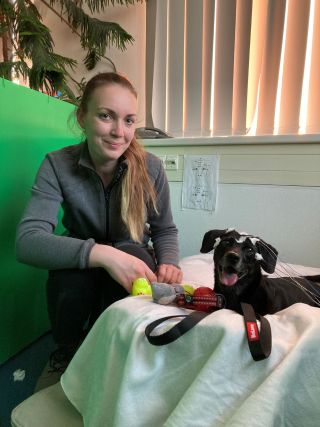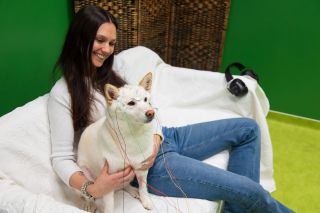Neuroscience
Can Dogs Understand Object Words?
Your pet may understand more than they're letting on.
Updated March 25, 2024 Reviewed by Tyler Woods
Key points
- Human language is referential, meaning that certain words represent certain objects.
- When presented with an object word, people activate a matching mental representation in their minds.
- EEG brain recordings show that dogs understand the referential nature of object words similarly to people.
- Dogs may activate mental representations of words, even if they don't respond to the words behaviorally.

Humans use words to refer to objects in the environment. We understand that certain words “stand for” certain objects, and this understanding is assumed to depend on the formation of mental representations of words. If I say “tennis ball” to you, we both activate mental representations in our minds. This is how we can understand each other, even if we are talking about things that are not directly present. This is called referential understanding, and it’s been argued that it is uniquely human.
Now, a new study shows that dogs may understand certain object words in a similar way. Brain recordings from dogs suggest that they, like humans, activate mental representations in their minds when they hear those words. The results provide the first neural evidence for object word knowledge in a nonhuman animal.
Inside Dogs’ Minds
Scientists have long debated whether any nonhuman animal is capable of referential understanding. There is suggestive behavioral data from wild animals in the field and from a few acculturated individuals of certain species—apes, dolphins, and parrots—that seem to indicate some animals possess the ability. But scientists do not agree on whether these behaviors represent true understanding or simply a stimulus response, says Marianna Boros, of Eötvös Loránd University in Hungary, one of the study’s authors.

“There is always the critique that if an animal gives a vocalization or sign or hears a word and reacts to that, does it really understand? Does it activate mental processes, or is it just a stimulus response behavior without understanding the meaning of it?”
The evidence for referential understanding in pet dogs is also inconclusive. There are a few dogs with the ability to learn the names of hundreds of toys. But behavioral tests of object word knowledge in most dogs are unsuccessful; when asked to retrieve a toy based on its name, they tend to perform at chance level.
Boros says there are numerous factors that can confound behavioral studies of word knowledge in dogs, including the subjects’ energy, motivation, and understanding of the task. She and her colleagues thought that neural measures may be more sensitive to implicit or passive word knowledge. They decided to probe dogs’ referential understanding by measuring brain activity using noninvasive electroencephalogram (EEG).
In human EEG studies, when a word is presented and then a different object is shown, the person’s brain activity changes in a specific way—essentially, this is a neural marker of semantic understanding. The effect is even seen in preverbal infants.

Boros, with co-first author Lilla Magyari and colleagues, recruited dog owners whose dogs knew at least five object words. After the dog was made comfortable and fitted with external electrodes, the owner would say the words for toys their dogs knew and then show them an object. Sometimes, they presented the matching toy, while other times they showed an object that didn’t match. For example, an owner would say, “Zara, look, the ball,” and then present either the ball or another object while the dog’s brain activity was captured on EEG.
“Our idea was that if dogs understand the word, then when they hear the word, they will activate a mental representation,” writes Boros. “When this mental representation is activated and then the owner shows a toy that does not match the mental representation, this should be reflected in their brain responses.”
Understanding Each Other
The brain recordings showed a different pattern when the dogs were presented with a matching object versus a mismatched one, and these characteristic patterns occurred in a comparable time window as similar patterns in humans. In addition, there was a greater difference in brain patterns for words that dogs knew better, adding further evidence that the dogs truly understood the words.
What’s more, the researchers found that the size of a dog’s vocabulary did not impact the differences in brain activity in matching and mismatching conditions. In other words, whether a dog knew five words or 500 words, known words activated mental representations. According to the researchers, this suggests that referential understanding is generally present in pet dogs and not just in certain exceptional individuals with large vocabularies.

Dogs could show this capacity to understand words in a referential way because of the domestication process or their experience of living among people. It is also possible that referential understanding is more general across mammals.
“This is an important addition to the debate on whether animals communicate about things other than their emotions,” writes Boros. “We know that animals will vocalize to communicate their internal states, but whether they are also vocalizing to ‘talk’ about things that are outside of themselves is not completely understood... Now that we see this capacity in dogs, we might want to rethink whether other mammals may use vocalizations to refer to external things in their natural environments.”
Boros and colleagues say the findings also have implications for dog owners: Your pet may passively understand more words than they let on.
“I think it is important that we use words and name things for dogs even if we think they don’t understand,” Boros writes. “Our study shows that they might passively grasp those meanings. So dog owners shouldn’t get discouraged if their dog does not respond to some words. They might still understand what you are saying.”
Facebook image: Prostock-studio/Shutterstock
References
Boros M, Magyari L, Morvai B, Hernández-Pérez R, Dror S, and Andics A. Neural evidence for referential understanding of object words in dogs. Current Biology 34:1-5. Doi: 10.1016/j.cub.2024.02.029.




